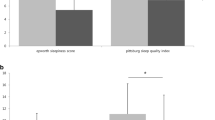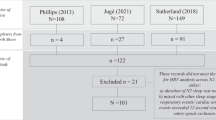Abstract
Purpose
The aim of this study is to evaluate the changes of sleep quality in patients using a mandibular advancement device (MAD) for obstructive sleep apnea (OSA) based upon cardiopulmonary coupling (CPC).
Methods
A total of 52 patients (mean age 53.7 ± 9.6 years, range 33–74 years) were included in this study. Of them, there were 47 males (90.4 %). All subjects were diagnosed with OSA after in-laboratory full-night polysomnography and reevaluated after 3-month use of a MAD. At baseline, apnea-hypopnea index (AHI) was 33.6 ± 17.0, Epworth sleepiness scale was 10.5 ± 4.8, and Pittsburgh sleep quality index was 5.8 ± 2.8. The CPC parameters were extracted from single-lead electrocardiography of polysomnography. We compared CPC parameters at baseline with those after 3-month use of a MAD.
Results
All respiratory indices improved with the use of MAD. However, there were no differences in the sleep architectures except N3 sleep (3.7 ± 4.3 to 6.9 ± 6.4 %, p < 0.001). The CPC parameters showed a significant improvement with the use of MAD. Low-frequency coupling (59.5 ± 16.1 to 47.7 ± 14.8 %, p < 0.001) and elevated low-frequency coupling (44.6 ± 18.4 to 32.6 ± 15.7 %, p < 0.001) significantly decreased. High-frequency coupling (28.6 ± 16.0 to 36.5 ± 15.7 %, p = 0.004) and very low frequency coupling (11.7 ± 7.2 to 15.3 ± 6.6 %, p = 0.028) significantly increased. The change of AHI significantly correlated with changes of the CPC parameters: negatively correlated with high-frequency coupling change (r = −0.572, p < 0.001) and positively correlated with low-frequency and elevated low-frequency coupling changes (r = 0.604 and 0.497, respectively; p < 0.001 in both). However, the changes of Epworth sleepiness scale and Pittsburgh sleep quality index after MAD therapy showed no significant correlation with the changes in the CPC parameters.
Conclusions
To our knowledge, this is the first study to evaluate the quality of sleep in patients using a MAD for their OSA based upon CPC analysis. Low-frequency coupling decreased as AHI improved, while high-frequency coupling increased as AHI improved. The CPC parameters showed that the sleep quality was improved by MAD therapy.

Similar content being viewed by others
References
Yoshida K (2000) Effects of a mandibular advancement device for the treatment of sleep apnea syndrome and snoring on respiratory function and sleep quality. Cranio 18(2):98–105
Loredo JS, Ancoli-Israel S, Dimsdale JE (2001) Sleep quality and blood pressure dipping in obstructive sleep apnea. Am J Hypertens 14(9 Pt 1):887–892
Loredo JS, Ancoli-Israel S, Kim EJ, Lim WJ, Dimsdale JE (2006) Effect of continuous positive airway pressure versus supplemental oxygen on sleep quality in obstructive sleep apnea: a placebo-CPAP-controlled study. Sleep 29(4):564–571
Penzel T, McNames J, Murray A, de Chazal P, Moody G, Raymond B (2002) Systematic comparison of different algorithms for apnoea detection based on electrocardiogram recordings. Med Biol Eng Comput 40(4):402–407
Roche F, Pichot V, Sforza E, Court-Fortune I, Duverney D, Costes F, Garet M, Barthelemy JC (2003) Predicting sleep apnoea syndrome from heart period: a time-frequency wavelet analysis. Eur Respir J 22(6):937–942
Penzel T, Kantelhardt JW, Grote L, Peter JH, Bunde A (2003) Comparison of detrended fluctuation analysis and spectral analysis for heart rate variability in sleep and sleep apnea. IEEE Trans Biomed Eng 50(10):1143–1151
Rajendra Acharya U, Paul Joseph K, Kannathal N, Lim CM, Suri JS (2006) Heart rate variability: a review. Med Biol Eng Comput 44(12):1031–1051
Thomas RJ, Mietus JE, Peng CK, Goldberger AL (2005) An electrocardiogram-based technique to assess cardiopulmonary coupling during sleep. Sleep 28(9):1151–1161
Langley P, Bowers EJ, Murray A (2010) Principal component analysis as a tool for analyzing beat-to-beat changes in ECG features: application to ECG-derived respiration. IEEE Trans Biomed Eng 57(4):821–829
Kushida CA, Morgenthaler TI, Littner MR, Alessi CA, Bailey D, Coleman J Jr, Friedman L, Hirshkowitz M, Kapen S, Kramer M, Lee-Chiong T, Owens J, Pancer JP (2006) Practice parameters for the treatment of snoring and obstructive sleep apnea with oral appliances: an update for 2005. Sleep 29(2):240–243
Thomas RJ, Mietus JE, Peng CK, Gilmartin G, Daly RW, Goldberger AL, Gottlieb DJ (2007) Differentiating obstructive from central and complex sleep apnea using an automated electrocardiogram-based method. Sleep 30(12):1756–1769
Lee SH, Choi JH, Park IH, Kim TH, Lee HM, Park HK, Thomas RJ, Shin C, Yun CH (2012) Measuring sleep quality after adenotonsillectomy in pediatric sleep apnea. Laryngoscope 122(9):2115–2121
The Report of an American Academy of Sleep Medicine Task Force (1999) Sleep-related breathing disorders in adults: recommendations for syndrome definition and measurement techniques in clinical research. Sleep 22(5):667–89
Parrino L, Ferri R, Bruni O, Terzano MG (2012) Cyclic alternating pattern (CAP): the marker of sleep instability. Sleep Med Rev 16(1):27–45
Ramar K, Desrues B, Ramar P, Morgenthaler TI (2013) Analysis of cardiopulmonary coupling to assess adaptive servo-ventilation success in complex sleep apnea management. Sleep Breath 17(2):861–866
Guo D, Peng CK, Wu HL, Mietus JE, Liu Y, Sun RS, Thomas RJ (2011) ECG-derived cardiopulmonary analysis of pediatric sleep-disordered breathing. Sleep Med 12(4):384–389
Ibrahim LH, Jacono FJ, Patel SR, Thomas RJ, Larkin EK, Mietus JE, Peng CK, Goldberger AL, Redline S (2010) Heritability of abnormalities in cardiopulmonary coupling in sleep apnea: use of an electrocardiogram-based technique. Sleep 33(5):643–646
Koo BB, Wiggins R, Molina C (2012) REM rebound and CPAP compliance. Sleep Med 13(7):864–868
Brillante R, Cossa G, Liu PY, Laks L (2012) Rapid eye movement and slow-wave sleep rebound after one night of continuous positive airway pressure for obstructive sleep apnoea. Respirology 17(3):547–553
Harrington J, Schramm PJ, Davies CR, Lee-Chiong TL Jr (2013) An electrocardiogram-based analysis evaluating sleep quality in patients with obstructive sleep apnea. Sleep Breath. doi:10.1007/s11325-013-0804-9
Acknowledgments
This research was partly supported by SNUBH Grant No. 02-2012-053.
Conflict of interest
None of the authors declare a conflict of interest in relation to this work.
Author information
Authors and Affiliations
Corresponding author
Rights and permissions
About this article
Cite this article
Lee, W.H., Ahn, JC., We, J. et al. Cardiopulmonary coupling analysis: changes before and after treatment with a mandibular advancement device. Sleep Breath 18, 891–896 (2014). https://doi.org/10.1007/s11325-014-0961-5
Received:
Revised:
Accepted:
Published:
Issue Date:
DOI: https://doi.org/10.1007/s11325-014-0961-5




